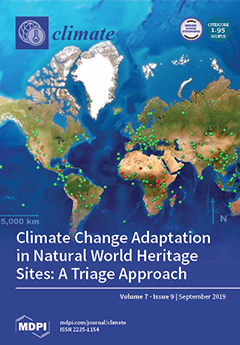Open AccessFeature PaperArticle
Potential Transient Response of Terrestrial Vegetation and Carbon in Northern North America from Climate Change
by
Steven A. Flanagan, George C. Hurtt, Justin P. Fisk, Ritvik Sahajpal, Maosheng Zhao, Ralph Dubayah, Matthew C. Hansen, Joe H. Sullivan and G. James Collatz
Cited by 5 | Viewed by 3696
Abstract
Terrestrial ecosystems and their vegetation are linked to climate. With the potential of accelerated climate change from anthropogenic forcing, there is a need to further evaluate the transient response of ecosystems, their vegetation, and their influence on the carbon balance, to this change.
[...] Read more.
Terrestrial ecosystems and their vegetation are linked to climate. With the potential of accelerated climate change from anthropogenic forcing, there is a need to further evaluate the transient response of ecosystems, their vegetation, and their influence on the carbon balance, to this change. The equilibrium response of ecosystems to climate change has been estimated in previous studies in global domains. However, research on the transient response of terrestrial vegetation to climate change is often limited to domains at the sub-continent scale. Estimation of the transient response of vegetation requires the use of mechanistic models to predict the consequences of competition, dispersal, landscape heterogeneity, disturbance, and other factors, where it becomes computationally prohibitive at scales larger than sub-continental. Here, we used a pseudo-spatial ecosystem model with a vegetation migration sub-model that reduced computational intensity and predicted the transient response of vegetation and carbon to climate change in northern North America. The ecosystem model was first run with a current climatology at half-degree resolution for 1000 years to establish current vegetation and carbon distribution. From that distribution, climate was changed to a future climatology and the ecosystem model run for an additional 2000 simulation years. A model experimental design with different combinations of vegetation dispersal rates, dispersal modes, and disturbance rates produced 18 potential change scenarios. Results indicated that potential redistribution of terrestrial vegetation from climate change was strongly impacted by dispersal rates, moderately affected by disturbance rates, and marginally impacted by dispersal mode. For carbon, the sensitivities were opposite. A potential transient net carbon sink greater than that predicted by the equilibrium response was estimated on time scales of decades–centuries, but diminished over longer time scales. Continued research should further explore the interactions between competition, dispersal, and disturbance, particularly in regards to vegetation redistribution.
Full article
►▼
Show Figures





